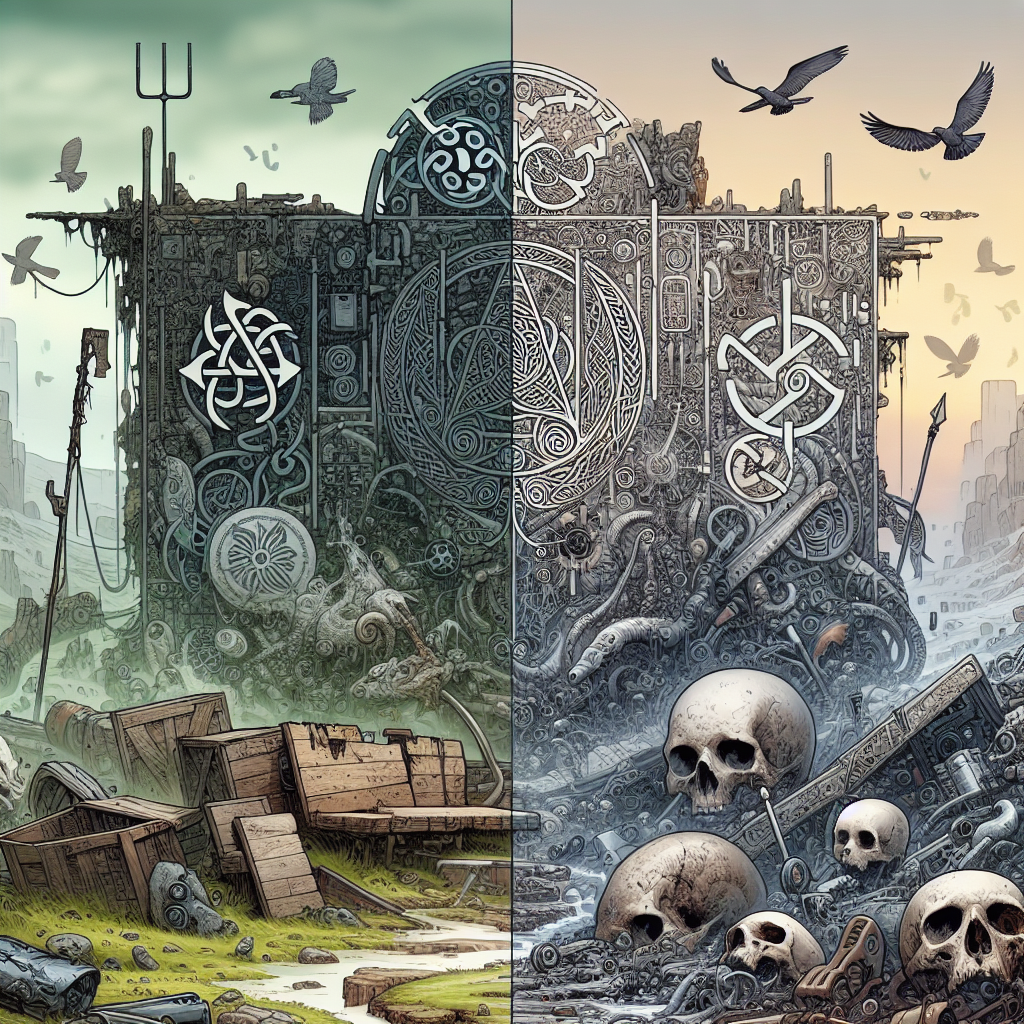In Jewish thought, the concepts of Sheol and Gehenna are often mentioned when it comes to the afterlife. While these two terms may seem interchangeable, they actually hold different meanings and serve different purposes in Jewish theology. To truly understand Jewish afterlife beliefs, it’s important to explore the difference between Sheol and Gehenna in depth.
Key Takeaways:
- Sheol and Gehenna are two distinct concepts associated with the afterlife in Jewish thought.
- Sheol is often described as the neutral realm of the dead, while Gehenna is a place of punishment for the wicked.
- Understanding the difference between Sheol and Gehenna gives insight into Jewish concepts of divine justice and moral responsibility.
Sheol: The Abode of the Dead
In Jewish thought, Sheol is often described as the realm of the dead, a place where the souls of the deceased reside after death. Unlike Gehenna, Sheol is not seen as a place of punishment, but rather a neutral state of existence. It is believed to be a dark and shadowy place, devoid of any joy or suffering.
The concept of Sheol can be traced back to ancient Hebrew texts, where it was used to describe the abode of both the righteous and the wicked. In Jewish tradition, Sheol is considered a temporary dwelling place until the final judgment. The term is used in the Hebrew Bible to describe the afterlife, as well as in Jewish liturgy to refer to death itself.
While Sheol is not associated with punishment or reward, it does hold significance in Jewish thought. For example, it is often used to emphasize the importance of living a good life, as it is believed that everyone will eventually end up in Sheol, regardless of their deeds in life.
Exploring Sheol and Gehenna in Jewish tradition reveals the unique perspectives on the afterlife held by the Jewish people.
Sheol: The Abode of the Dead
In Jewish thought, Sheol is often described as the realm of the dead. It is a place where the souls of the deceased reside after death, but it is not seen as a place of punishment. Rather, it is a neutral state of existence. According to Jewish tradition, Sheol is a temporary dwelling place until the final judgment.
The word Sheol is mentioned in various Hebrew texts, including the Old Testament. It is believed to be a dark and shadowy place, devoid of any joy or suffering. The idea of Sheol originated from the ancient Near Eastern belief that the dead go to a subterranean realm. In Jewish tradition, it is viewed as a place of waiting where righteous individuals await the resurrection.
Sheol is distinct from Gehenna in its nature and purpose. While Sheol represents a general abode of the dead, Gehenna signifies punishment and purification for the wicked. The two concepts serve different purposes within Jewish theology and are often explored together in religious texts.
“For You will not abandon my soul to Sheol; Nor will You allow Your Holy One to undergo decay.” – Psalm 16:10
The concept of Sheol has also acquired symbolic meaning, representing the absence of God and the despair and loneliness that can come with it. However, this meaning is not universal and varies across interpretations of Jewish theology and literature.
Key Differences Between Sheol and Gehenna
While both Sheol and Gehenna are associated with the afterlife, they differ significantly in their nature and purpose. Sheol represents a general abode of the dead, where all souls eventually go, regardless of their deeds in life. Gehenna, on the other hand, signifies a place of punishment and purification for the wicked. It is reserved for those who have committed serious transgressions and serves as a means of atonement.
The Jewish understanding of Sheol and Gehenna highlights their beliefs in moral responsibility, divine justice, and the consequences of one’s actions. Sheol represents a neutral state of existence, while Gehenna symbolizes the punishment for wrongdoing.
It is important to note that Sheol and Gehenna do not represent an eternal destination, as Jewish tradition teaches that the soul is ultimately reunited with the body in the World to Come. However, they serve as a means of understanding the Jewish concept of the afterlife and the role of divine judgment in the moral order of the universe.
Historical and Symbolic Significance
Throughout Jewish history, the concepts of Sheol and Gehenna have played significant roles in shaping afterlife beliefs. The idea of Sheol can be traced back to the Hebrew Bible, where it was described as an underworld for all souls to reside in after death. Over time, Sheol evolved to represent a place of waiting until judgment day. In contrast, Gehenna gained prominence during the Second Temple period and became associated with punishment and purification for the wicked.
Aside from their literal meanings, Sheol and Gehenna also hold symbolic significance in Jewish tradition. Sheol represents the inevitability of death and the transient nature of life. The concept of Gehenna reflects the Jewish belief in moral responsibility, divine justice and the consequences of one’s actions. It has been used metaphorically to describe the consequences of disobedience, unrighteousness, and sin.
By exploring the difference between Sheol and Gehenna, we gain a deeper understanding of Jewish theology and its teachings on the afterlife. These concepts emphasize the importance of living a righteous and moral life in this world and that every action has consequences, both in this life and the next.
Conclusion
In conclusion, Sheol and Gehenna are two distinct concepts in Jewish afterlife beliefs, each with its own unique characteristics and significance. Sheol represents the abode of the dead, a neutral place where all souls eventually go, while Gehenna symbolizes punishment and purification for the wicked, reserved for those who have committed serious transgressions.
These concepts reflect the Jewish understanding of justice and moral responsibility, emphasizing the consequences of one’s actions. They have historical and symbolic significance, influencing Jewish thought throughout history and representing concepts beyond the literal abode of the dead and punishment.
By exploring the difference between Sheol and Gehenna, we gain a deeper understanding of Jewish theology and its teachings on the afterlife. It highlights the importance of living a righteous and moral life, as it ultimately determines one’s fate after death.
Overall, the Jewish concept of Sheol and Gehenna provides insight into the Jewish understanding of the nature of the divine and the consequences of human actions. It reminds us to live a life of moral and ethical responsibility, as our actions will ultimately determine our fate in the afterlife.
FAQ
Q: What is the difference between Sheol and Gehenna in Jewish thought?
A: Sheol and Gehenna are two distinct concepts associated with the afterlife in Jewish thought. Sheol represents the general abode of the dead, a neutral state of existence where souls reside after death. Gehenna, on the other hand, is a place of punishment and purification for the wicked.
Q: What is Sheol?
A: Sheol is often described as the realm of the dead in Jewish tradition. It is a place where the souls of the deceased temporarily dwell until the final judgment. Sheol is not seen as a place of punishment but rather a neutral state of existence.
Q: What is Gehenna?
A: Gehenna is a place associated with punishment in Jewish thought. It is referred to as the Valley of Hinnom and is believed to be a site of divine judgment and purification for the wicked. Gehenna symbolizes the consequences of sinful actions and represents a place of fiery torment.
Q: How do Sheol and Gehenna differ?
A: Sheol and Gehenna differ in their nature and purpose. Sheol is the general abode of the dead, where all souls eventually go regardless of their deeds in life. Gehenna, on the other hand, is a place of punishment and purification for those who have committed serious transgressions during their lives.
Q: What is the historical and symbolic significance of Sheol and Gehenna?
A: Sheol and Gehenna have played significant roles in Jewish thought throughout history. Sheol can be traced back to ancient Hebrew texts, while Gehenna gained significance during the Second Temple period. These concepts also have symbolic meanings, representing justice, moral responsibility, and the consequences of one’s actions.



